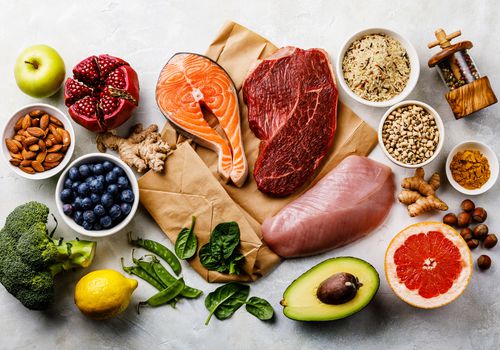You probably know that sugary foods aren’t the healthiest thing to eat. But you’re also likely giving in to your sweet tooth several times a day. Possibly eating even more sugar than you realize!
The usual suspects — sugar in your morning coffee, soda in the afternoon, ice cream after dinner — can add up to a hefty helping of non-nutritious calories. But “hidden” sugar also lurks in less obvious foods, including bread, salty snacks, yogurt, salad dressing, and energy bars. Which means many of us are eating and drinking a potentially harmful amount of added sugar.
In fact, Americans consume an average 17 teaspoons of added sugar daily, which is a whopping 71 grams and 270 calories, according to the U.S. Department of Health and Human Services. Consider this: With a 12-ounce can of Coke containing 39 grams of sugar and 140 calories, it’s easy to see why our average sugar intake is nearly three times more than the 6 teaspoons (25 grams) recommended for women and about double the 9 teaspoons (37.5 grams) recommended for men by the American Heart Association.
What’s more, research is shedding light on how sugar affects the brain in ways that mimic the mechanisms of addiction to cocaine and other substances, as found in a review of research published in Current Opinion in Clinical Nutrition & Metabolic Care in 2013. In another study, published in the Journal of Addiction Medicine in 2009, neuroscientists used brain imaging to show that eating sugar triggers the release of dopamine — a feel-good chemical — in the pleasure center of the brain, and that stimulation leaves the person wanting more. In other words, because of the way the brain is hardwired, eating sweets makes you want to eat more sweets. Making it hard to stop after just one taste of ice cream or bite of chocolate.
Overindulging has other consequences: Diets high in added sugar have long been linked to weight gain and a higher risk of such chronic conditions as obesity, type 2 diabetes, high cholesterol, hypertension, and heart disease. And a 2017 study published in Clinical Science concluded that only three months on a high-sugar diet alters the body’s fat metabolism in a way that may raise the risk of cardiovascular disease in otherwise healthy people.
On the positive side, eating less sugar is tied to better overall health and improved appearance, including younger looking skin, more consistent energy levels, and, according to a report published in 2017 in the online journal BMJ Open, a nearly 10 percent reduction in the risk of coronary heart disease and a 20 percent reduction in the risk of type 2 diabetes.
The good news? With a few simple changes, you can circumvent the sugar loop and take control of your cravings. Whether you’re trying to ditch sugar completely or just cut back on how many sweets you eat, here are tips to help you get started.
1. Eat whole foods that contain natural sugars.
Chemically, sugar is the same whether it’s found in a carrot, an apple, or a candy bar. But fruits and vegetables are also full of fiber, vitamins, and minerals. These other nutrients slow down digestion and the flow of sugar into the bloodstream. Which moderates the release of dopamine into the brain.
So-called “added sugar” is where you should focus on cutting back. Try a piece of fruit rather than drinking a soda to get through an afternoon slump. Buy plain yogurt and add fresh berries instead of flavored yogurt packed with sugar or syrup. And a handful of almonds, walnuts, and pecans are a better on-the-go choice than an energy bar.
2. Try a clinically proven lozenge.
Establishing a new habit takes time, and it can be tempting to backslide in the beginning. Until healthy is your new normal, a simple lozenge can help you stay on track.
Sweet Defeat, a new plant-based lozenge, is clinically proven to stop sugar cravings and reduce sugar consumption and is the only product of its kind. Made with Gymnema leaf extract, zinc, sorbitol, and mint, Sweet Defeat works by binding to the sweet-taste receptors in your taste buds, blocking the taste of sugar in your food in seconds and reducing your sugar cravings for up to an hour.

Source: Everyday Health
In a recent behavioral study, researchers at the Oregon Research Institute found that consuming a Sweet Defeat lozenge produced a 31 percent reduction in desire for candy and a 44 percent reduction in total candy intake. The results of the double-blind, placebo-controlled study were published in the Journal of Psychopharmacology in 2017 and confirmed by a replicate study, conducted by Global Clinicals, Inc., in Los Angeles, and published in the Journal of Advancement in Medicinal Plant Research in 2017.
Sugar cravings can hit at any time. After dinner, or while getting afternoon coffee (hmm, doughnut). Walking past the snack table at the office, or watching late-night TV. To help reset your patterns, use one Sweet Defeat lozenge whenever your sugar appetite kicks in.
Post-meal cravings are mostly a matter of habit. You’re not actually hungry (you just ate!). But even the small amount of sugar often added to salad dressings, pasta sauce, bread, or marinades can trigger the desire for more sugar. Or maybe your usual routine calls for something sweet to end the meal. That pint of ice cream is especially tempting, as is that tin full of homemade chocolate chip cookies.
To shake up your routine, measure out one serving size of your favorite sweet. A thin slice of cake, one scoop of ice cream, or a small cookie — before dinner. And store it in a glass or plastic container. Stash the rest in the back of the cabinet, refrigerator, or freezer. That way it’s more difficult to go back for seconds. And for an afternoon sweet tooth, buy individually wrapped chocolate squares to keep in your desk drawer. Bring one to the office every day for the end of lunch, and leave the bag at home.
4. Indulge with dessert, not a sugary snack.
Eating sweets as a between-meal snack quickly spike your blood sugar and your brain’s sugar-craving response. With no other nutrients as a buffer, you’re more likely to binge on the sweet stuff.
If a completely sugarless life isn’t for you, save the sugar for dessert. When eaten after a meal of lean protein, complex carbohydrates, and healthy fats. Dessert won’t have quite the impact on your blood sugar. You’re also more likely to feel satisfied by a small bite of something sweet.
5. Eat foods high in minerals.
Sugar cravings can be caused by a mineral deficiency, particularly a need for magnesium, chromium, and zinc. Magnesium — needed by the body for numerous functions, including regulating blood pressure and blood sugar, strengthening bones, and maintaining a healthy heart — is found in dark leafy greens, avocado, brown rice, quinoa, nuts, seeds, and raw cacao. Foods high in chromium, which regulates blood sugar and cholesterol levels, include broccoli, and sweet potatoes. And good sources of zinc, needed for insulin and glucose utilization, are oysters, whole grains, pastured eggs, pumpkin seeds, and Brazil nuts.
6. Walk it off.
The next time you feel the urge to track down some chocolate or hit the vending machine for something sweet, take a walk instead. A 15-minute walk of moderate intensity proved to reduce cravings for high-calorie sugary snacks, even in times of stress, in a 2015 study published in PLoS One. Besides, the change of scenery will do you good — just be sure to stay off the block with the bakery.
7. Take it slow.
As you start to make changes to keep your sweet tooth under control, don’t try to cut out all sugary foods at once. Going cold turkey can backfire and cause even more intense cravings for something sweet. Pace yourself. Focus on eating healthy, filling foods for meals and snacks. Also plan to eat one serving of a high-quality dessert when you do want to indulge.
For more information click here.
By:Suzanne McElfresh
Source Everyday Health






Leave A Comment
You must be logged in to post a comment.